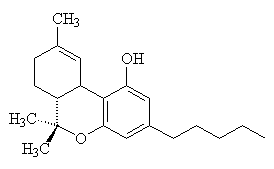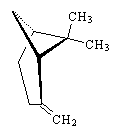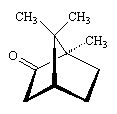Tetrahydrocannabinol - THC
 Tetrahydrocannabinol (THC) is the active chemical in cannabis and is one of the oldest hallucinogenic drugs known. There is evidence that cannabis extracts were used by the Chinese as a herbal remedy since the first century AD. Cannabis comes from the flowering tops and leaves of the hemp plant, Cannabis sativa (shown in the picture on the right). For centuries this plant has been widely cultivated around the world for its fibres, and indeed the word canvas, which is a material made from woven hemp fibres, takes its name from cannabis. However, cannabis is more commonly known as the source of the marijuana drug, although the word marijuana applies both to the whole plant, and to the resin from it (although this is sometimes also called hashish).
Tetrahydrocannabinol (THC) is the active chemical in cannabis and is one of the oldest hallucinogenic drugs known. There is evidence that cannabis extracts were used by the Chinese as a herbal remedy since the first century AD. Cannabis comes from the flowering tops and leaves of the hemp plant, Cannabis sativa (shown in the picture on the right). For centuries this plant has been widely cultivated around the world for its fibres, and indeed the word canvas, which is a material made from woven hemp fibres, takes its name from cannabis. However, cannabis is more commonly known as the source of the marijuana drug, although the word marijuana applies both to the whole plant, and to the resin from it (although this is sometimes also called hashish).
Cannabis contains approximately 60 different psychoactive chemicals called cannabinoids, of which the most important one is tetrahydrocannabinol (THC). The mode of action of THC is still not properly understood, although it is known that of the two stereoisomers (mirror images), the (-)-form (the left-handed form of the molecule) is 10-15 times more potent than the (+)-form.
 | THC - the active component of cannabis
|
The cannabinoids belong to a class of chemicals called terpenoids, meaning terpene-like. These compounds occur as essential oils within many plants and some are involved in the formation of vitamins, steroids, pigments and odours. The perfume industry relies on compounds such as these, and they also find a variety of uses in the food and pharmaceutical industry as flavour and odour improvers. Terpenes can be linear (such as geraniol or citronella) or cyclic as in THC. Examples of some other simple cyclic terpenes are shown below.
 |  |  |
menthol
(peppermint oil) | b-pinene
(turpentine) | Camphor
(from the camphor tree) |
THC as an Illegal Drug
 The cannabinoids are basically non-polar molecules, with low solubility in water, so they are normally self-administered by smoking. The volatilised fractions are inhaled as a vapour and give rise to a number of physiological effects. These effects depend very much upon the expectations and mood of the user, the quantity taken, and the possible presence of other drugs (such as alcohol) in the body. Generally people experience a pleasurable state of relaxation, with heightened sensory experiences of taste, sound and colour. Repeated experiments have failed to show any short term dangers, although it hasn't been proven to be 'safe' in the pharmacological sense either. THC is non-addictive and there are no withdrawal symptoms. However, one of the side-effects of its use is to make the user drowsy, with reduced concentration and short term memory. As a result, it was made illegal in the UK for recreational use in 1928, although it is still legal in a number of other countries.
The cannabinoids are basically non-polar molecules, with low solubility in water, so they are normally self-administered by smoking. The volatilised fractions are inhaled as a vapour and give rise to a number of physiological effects. These effects depend very much upon the expectations and mood of the user, the quantity taken, and the possible presence of other drugs (such as alcohol) in the body. Generally people experience a pleasurable state of relaxation, with heightened sensory experiences of taste, sound and colour. Repeated experiments have failed to show any short term dangers, although it hasn't been proven to be 'safe' in the pharmacological sense either. THC is non-addictive and there are no withdrawal symptoms. However, one of the side-effects of its use is to make the user drowsy, with reduced concentration and short term memory. As a result, it was made illegal in the UK for recreational use in 1928, although it is still legal in a number of other countries.
Medical Uses
Apart from the recreational uses and abuses, THC does have some medical uses. Its anti-emetic properties (inhibits vomiting) are particularly useful in the treatment of cancer patients on chemotherapy. Also, as THC increases the appetite and reduces the vomit response, it is starting to be used in the treatment of anorexia and other eating disorders.
References:
- Organic Chemistry, Morrison and Boyd (Allyn and Bacon, 1983).
- Biochemistry, L. Stryer (W.H. Freeman and Co, San Francisco, 1975).
- Molecules, P.W. Atkins (W.H. Freeman and Co, New York, 1987)
 Tetrahydrocannabinol (THC) is the active chemical in cannabis and is one of the oldest hallucinogenic drugs known. There is evidence that cannabis extracts were used by the Chinese as a herbal remedy since the first century AD. Cannabis comes from the flowering tops and leaves of the hemp plant, Cannabis sativa (shown in the picture on the right). For centuries this plant has been widely cultivated around the world for its fibres, and indeed the word canvas, which is a material made from woven hemp fibres, takes its name from cannabis. However, cannabis is more commonly known as the source of the marijuana drug, although the word marijuana applies both to the whole plant, and to the resin from it (although this is sometimes also called hashish).
Tetrahydrocannabinol (THC) is the active chemical in cannabis and is one of the oldest hallucinogenic drugs known. There is evidence that cannabis extracts were used by the Chinese as a herbal remedy since the first century AD. Cannabis comes from the flowering tops and leaves of the hemp plant, Cannabis sativa (shown in the picture on the right). For centuries this plant has been widely cultivated around the world for its fibres, and indeed the word canvas, which is a material made from woven hemp fibres, takes its name from cannabis. However, cannabis is more commonly known as the source of the marijuana drug, although the word marijuana applies both to the whole plant, and to the resin from it (although this is sometimes also called hashish).



 The cannabinoids are basically non-polar molecules, with low solubility in water, so they are normally self-administered by smoking. The volatilised fractions are inhaled as a vapour and give rise to a number of physiological effects. These effects depend very much upon the expectations and mood of the user, the quantity taken, and the possible presence of other drugs (such as alcohol) in the body. Generally people experience a pleasurable state of relaxation, with heightened sensory experiences of taste, sound and colour. Repeated experiments have failed to show any short term dangers, although it hasn't been proven to be 'safe' in the pharmacological sense either. THC is non-addictive and there are no withdrawal symptoms. However, one of the side-effects of its use is to make the user drowsy, with reduced concentration and short term memory. As a result, it was made illegal in the UK for recreational use in 1928, although it is still legal in a number of other countries.
The cannabinoids are basically non-polar molecules, with low solubility in water, so they are normally self-administered by smoking. The volatilised fractions are inhaled as a vapour and give rise to a number of physiological effects. These effects depend very much upon the expectations and mood of the user, the quantity taken, and the possible presence of other drugs (such as alcohol) in the body. Generally people experience a pleasurable state of relaxation, with heightened sensory experiences of taste, sound and colour. Repeated experiments have failed to show any short term dangers, although it hasn't been proven to be 'safe' in the pharmacological sense either. THC is non-addictive and there are no withdrawal symptoms. However, one of the side-effects of its use is to make the user drowsy, with reduced concentration and short term memory. As a result, it was made illegal in the UK for recreational use in 1928, although it is still legal in a number of other countries.